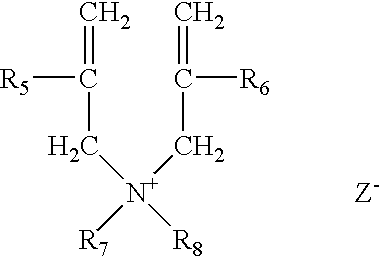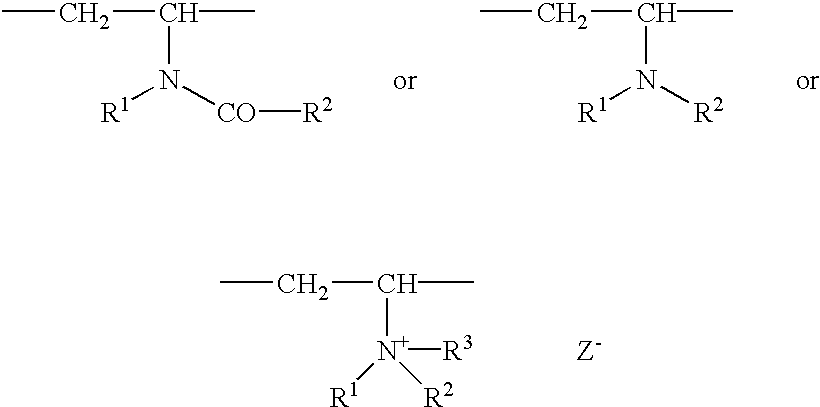Method for making hydrophobically associative polymers, methods of use and compositions
a hydrophobic associative polymer and polymer technology, applied in the direction of sedimentation separation, textiles and papermaking, chemical/physical processes, etc., can solve the problems of incomplete monomer conversion, difficult transportation and handling, and difficult agitation
- Summary
- Abstract
- Description
- Claims
- Application Information
AI Technical Summary
Benefits of technology
Problems solved by technology
Method used
Image
Examples
example 2
Brine Dispersion Polymerization of HAP
In the case of HAP polymer IV, a stabilizer brine solution is prepared by adding 240 grams of deionized (DI) water using an overhead mixer and gradually adding 1.2 grams of Galactasol gum while mixing at 400 rpm. The mixing is continued for 15 minutes until a homogeneous solution is formed. Thereafter, 60 grams of ammonium sulfate is added while mixing until all salt is dissolved.
A monomer solution is prepared by charging 55.4 grams of acrylamide (53% aqueous solution), 30.1 grams of acrylic acid (99%) and 4.5 grams of sodium lauryl sulfate (98%) into a beaker with a magnetic stir bar. The contents are stirred until a homogeneous solution is formed. 0.5 gram of lauryl acrylate (90%) and 0.25 gram of ethylenediaminetetraacetic acid (EDTA) (70% aqueous solution) are further charged to the monomer solution. The stirring is continued until the solution becomes homogeneous. Then, the monomer solution, the previous prepared stabilizer brine solution a...
example 3
Polymers (I-IV) are characterized by Brookfield viscosity and viscoelasticity.
Polymer II, a HAP made by micellar solution polymerization, has a gel appearance even at a 5% active content. On the other hand, polymer IV, a HAP made in accordance with the present invention, has a much lower bulk viscosity at a 10% active content than polymer II. The foregoing comparison shows that polymer IV, a HAP made in accordance with this invention, exhibits better and unexpected properties over the HAP made by micellar solution polymerization. In addition, polymer IV has a lower manufacturing cost and easier handling than polymer II.
Polymer I, a non HAP made by micellar solution polymerization, also has a gel appearance at a 5% active content, whereas polymer III, a non HAP made by brine dispersion, has a lower bulk viscosity at a 10% active content. Furthermore, the higher 0.5% solution viscosity of the non HAP (polymer III) indicates that HAP (polymer IV) made by brine dispersion method has hig...
example 4
Lauryl Methacrylate as the Hydrophobic Comonomer
Besides Lauryl Acrylate (LA), Lauryl Methacrylate (LMA) is also investigated as the hydrophobic comonomer for HAP brine dispersion polymerization. Polymer V is synthesized under the same conditions as polymer IV except that 0.26 gram of LMA is used instead of 0.7 gram of LA. Good dispersion along with high association property is obtained from this product. Furthermore, it appears that less amount of LMA (0.1 mol %) is required to achieve the similar association property as Polymer IV containing 0.25 mol % LA.
PUM
| Property | Measurement | Unit |
|---|---|---|
| Weight | aaaaa | aaaaa |
| Fraction | aaaaa | aaaaa |
| Fraction | aaaaa | aaaaa |
Abstract
Description
Claims
Application Information
 Login to View More
Login to View More - R&D
- Intellectual Property
- Life Sciences
- Materials
- Tech Scout
- Unparalleled Data Quality
- Higher Quality Content
- 60% Fewer Hallucinations
Browse by: Latest US Patents, China's latest patents, Technical Efficacy Thesaurus, Application Domain, Technology Topic, Popular Technical Reports.
© 2025 PatSnap. All rights reserved.Legal|Privacy policy|Modern Slavery Act Transparency Statement|Sitemap|About US| Contact US: help@patsnap.com



